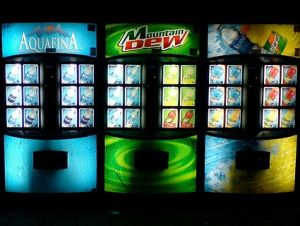Health News

Though schools are getting rid of soda in high numbers across the country, a lot of them still have relationships with Coke or Pepsi, something reporters can find out by simply asking administrators.
A 2005 survey found nearly half of elementary schools and about 80 percent of public high schools nationwide had pouring rights contracts with one or the other of the soda companies, which gives them exclusive rights to supply all the beverages in school snack bars, vending machines, school stores and at sports events.
The upside for the schools can include funding for field trips, gym uniforms, SMART boards and other perks, reports blogger Tom Philpott for Mother Jones. Philpott cites one study that shows students living in states with laws that limit junk food sales gained less weight ? an average of about 2.25 pounds for a 5-foot child ? than those that didn't. A study in California showed students consumed 158 less calories each day in schools where sodas were banned and new nutritional regulations were implemented in cafeterias.
But one study of 20,000 students found no correlation between obesity rates and access to soda at school. "The research is pretty mixed," Terry-McElrath said.
- 12 Ky. Schools Recognized For Efforts To Improve Student Health
A dozen Kentucky schools that participate in the Healthy Schools Program have been recognized for creating a culture of health and wellness in their classrooms. Ja'nel Johnson reports for WKMS, Murray State University's radio station. This is...
- New School Nutrition Requirements Extend To Snacks, Beverages And A La Carte Cafeteria Items
By Melissa Patrick Kentucky Health News Schools will have to provide students with healthier snacks and beverages during the school day this year as part of the U.S. Department of Agriculture's "Smart Snacks in School" standards. The Hunger-Free...
- Kentucky School Nutritionists Meet Amid Some Opposition To Federal School-lunch Guidelines Aimed At Curbing Child Obesity
Kentucky schools are working to adjust to the federal nutrition requirements for school lunches, but are facing some opposition from students, parents and some school nutritionists. The U.S. Department of Agriculture guidelines, aimed at curbing childhood...
- Poll Finds Parents Overwhelmingly Support More Nutritious School Food; Usda Expected To Issue New Guidelines
Photo by Reuters' Lucy NicholsonChocolate bars, Cheetos and cheesy fries may soon be a thing of the past at public schools in America, and that's fine with parents, a new poll has found. The survey found "most people agreed the chips, soda and...
- New Federal Rules On Vending Machines In Schools Are Expected In The Next Few Weeks
With new lunch standards set to kick in by next school year, the Obama administration is looking at its next target in the school food landscape: vending machines. New guidelines are expected to be released in the coming weeks "for foods that children...
Health News
Sodas losing fizz in schools, but exclusive deals remain

New research from the Robert Wood Johnson Foundation shows more than half of middle and high schools have purged the pop since the 2006-2007 school year. That year, 53.6 percent of high schools and 27.4 percent of middle schools gave students access to soda. In the 2010-2011 those numbers dropped to 25.3 in high schools and 12.5 percent in middle schools, reports Sarah Kliff for The Washington Post.
"You have policymakers at the state level, and also more local, moving policies into this directions," said researcher Yvonne Terry-McElrath. "You have policymakers at the state level, and also more local, moving policies into this direction. I also think you're seeing movement from parents and individuals who are becoming more aware of what is and isn't healthy."
That is the case in Kentucky. Under a state law passed a few years ago, students can only buy school-day-approved beverages ? 100 percent fruit juice, lowfat milk and any beverage that contains no more than 10 grams of sugar per serving ? during the school day. It may benefit reporters to ask school administrators though if there are vending machines at school that sell soda after the school day is finished, however.
 |
| Photo by Paul Robert Lloyd, via Flickr |
But one study of 20,000 students found no correlation between obesity rates and access to soda at school. "The research is pretty mixed," Terry-McElrath said.
- 12 Ky. Schools Recognized For Efforts To Improve Student Health
A dozen Kentucky schools that participate in the Healthy Schools Program have been recognized for creating a culture of health and wellness in their classrooms. Ja'nel Johnson reports for WKMS, Murray State University's radio station. This is...
- New School Nutrition Requirements Extend To Snacks, Beverages And A La Carte Cafeteria Items
By Melissa Patrick Kentucky Health News Schools will have to provide students with healthier snacks and beverages during the school day this year as part of the U.S. Department of Agriculture's "Smart Snacks in School" standards. The Hunger-Free...
- Kentucky School Nutritionists Meet Amid Some Opposition To Federal School-lunch Guidelines Aimed At Curbing Child Obesity
Kentucky schools are working to adjust to the federal nutrition requirements for school lunches, but are facing some opposition from students, parents and some school nutritionists. The U.S. Department of Agriculture guidelines, aimed at curbing childhood...
- Poll Finds Parents Overwhelmingly Support More Nutritious School Food; Usda Expected To Issue New Guidelines
Photo by Reuters' Lucy NicholsonChocolate bars, Cheetos and cheesy fries may soon be a thing of the past at public schools in America, and that's fine with parents, a new poll has found. The survey found "most people agreed the chips, soda and...
- New Federal Rules On Vending Machines In Schools Are Expected In The Next Few Weeks
With new lunch standards set to kick in by next school year, the Obama administration is looking at its next target in the school food landscape: vending machines. New guidelines are expected to be released in the coming weeks "for foods that children...
